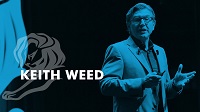Keith Weed, Unilever’s Chief marketing officer, has outlined ways for brands to avoid appearing next to inappropriate content online.
Speaking at Cannes Lions, Weed outlined what he called the “three Vs of digital marketing”.
The move follows criticism of YouTube this year for showing brand ads next to inappropriate content.
However, Weed said brands should be asking themselves some hard questions as well, and explained why Unilever hadn’t joined the rush of advertisers to pause spending on the YouTube platform.
“You will always get the occasional ad that goes in the wrong place,” he pointed out, whether that is in the digital environment or print. story. But the risks can be significantly reduced by focusing on the right things – which means looking beyond price.
“The cheapest media is on the lousy sites,” he said. “If you’ve got a really good place, you’re going to pay a little bit more for it: you get what you pay for.”
Not only that, but marketers can avail themselves of site-specific tools to mitigate risks further.
“What we were using were the highest level security guardrails on YouTube, and I think a lot of marketers just didn’t get it,” he stated.
Some, he suggested, had been too quick to blame YouTube and Google’s fault, “whereas some of them might have been saying, ‘well maybe we’re not buying as well as we should be’.”
Weed advised focusing on the “three Vs” of viewability, verification and value to build trusting, valuable relationships between brands and publishers.
In order to get to this stage he says that marketers must consider the three V’s:
- Viewability
- Verification
- Value
On the first he was adamant that 100% of the pixels must be in view – “that has to be a standard”. Unilever wouldn’t get away with selling a half-full tub of Ben & Jerry’s and justifying that by saying “as an industry we’ve decided that we’re only going to give you half a tub of ice cream, even though you bought a full one”.
Likewise, third-party verification must become the norm – simply because “the big digital media companies marking their own homework is not right … there are billions of dollars at stake here”.
The final issue is fraud, driven by bots. “I think the only way we’ll really solve this is to come back to the basics,” he said.
“We have one budget at the end of the day, one consumer, […] and we need to have one measurement system, across the system.”
